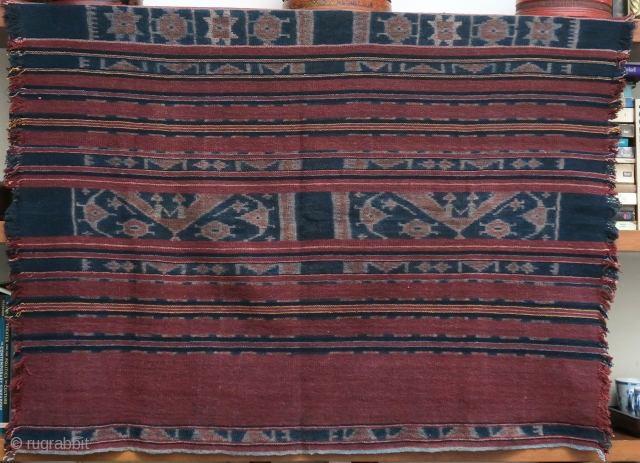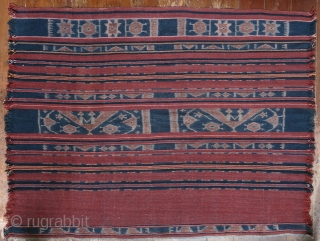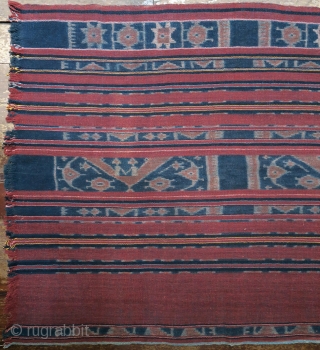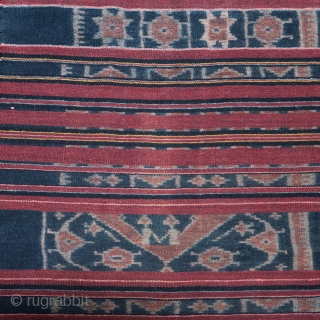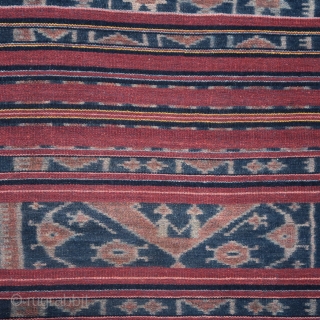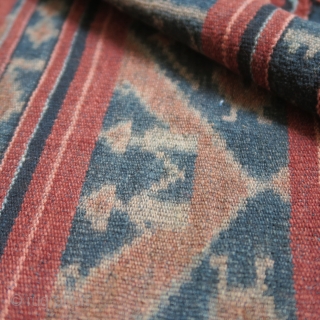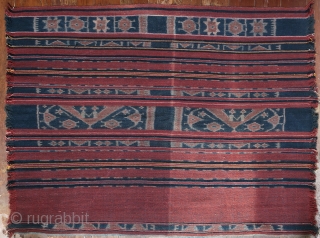Back
Indonesia | Bridewealth Ikat Panel
Lembata, Lamalera, Lamaholot people, mid 20th century
Handspun cotton, botanical indigo and morinda dyes, warp ikat
This is a lovely panel, made up of bands of ikat in three colours—indigo, morinda and natural—interleaved with solid rust-red bands and deep indigo stripes. The broadest ikat band has a composite figurative motif tena tuba moku (boat harpoons manta ray) representative of local life. a large fishing boat (tena, seen in cross-section) carries two people, and on either side is a giant manta ray (moku) and other sea creatures. The secondary ikat band contains eight-pointed stars. Narrower ikat stripes have small triangles, crosses and dash motifs, all worked in three-colour ikat. Accent pinstripes in commercially dyed yellow, pink and light blue sharpen the rhythm of the bands, and bring out the rich red-brown morinda dye distinctive to Lamalera weavings.
Context: Judging from its asymmetrical design format, this panel was woven to form one of the two outer sections of a three-panel tubeskirt, kefatek nai telo. The selvedge close to the band with stars (without the pale blue stripe) would be attached to the selvedge of an inner panel, and the opposite selvedge of the inner panel would likewise be attached to a panel mirroring this one. The long 3-panel piece of cloth would then be folded in half and stitched together at the warp ends to form a tube.
The small island of Lembata is famed for the outstanding quality of its ikat textiles. The most elaborately developed and locally differentiated textiles are the women’s cloth that are central components in the ceremonial gift exchanges which bind kin groups together and express their relationship. Given by the bride-givers, in counter-exchange for the men’s goods of elephant tusks presented by the bride-receivers, bridewealth textiles must be made from locally grown, handspun cotton and dyed with locally procured plant dyes, since there is a very strong symbolic value attached to the bridewealth cloth as an indigenous product. (Ruth Barnes, Ikat Textiles of Lamalera; ‘East Flores Regency’ in Roy Hamilton, ed., Gift of the Cotton Maiden) In Lamalera, the close association with the sea is reflected in the dominant sea imagery of its textiles.
The panel is in excellent condition apart from a sun-faded portion on one side (see last image). The other side is fresh, showing deeply saturated colours. The handspun cotton is medium weight, with a crisp texture and rich grainy hand. a tactile piece for the home.
105 x 78 cm.
Lembata, Lamalera, Lamaholot people, mid 20th century
Handspun cotton, botanical indigo and morinda dyes, warp ikat
This is a lovely panel, made up of bands of ikat in three colours—indigo, morinda and natural—interleaved with solid rust-red bands and deep indigo stripes. The broadest ikat band has a composite figurative motif tena tuba moku (boat harpoons manta ray) representative of local life. a large fishing boat (tena, seen in cross-section) carries two people, and on either side is a giant manta ray (moku) and other sea creatures. The secondary ikat band contains eight-pointed stars. Narrower ikat stripes have small triangles, crosses and dash motifs, all worked in three-colour ikat. Accent pinstripes in commercially dyed yellow, pink and light blue sharpen the rhythm of the bands, and bring out the rich red-brown morinda dye distinctive to Lamalera weavings.
Context: Judging from its asymmetrical design format, this panel was woven to form one of the two outer sections of a three-panel tubeskirt, kefatek nai telo. The selvedge close to the band with stars (without the pale blue stripe) would be attached to the selvedge of an inner panel, and the opposite selvedge of the inner panel would likewise be attached to a panel mirroring this one. The long 3-panel piece of cloth would then be folded in half and stitched together at the warp ends to form a tube.
The small island of Lembata is famed for the outstanding quality of its ikat textiles. The most elaborately developed and locally differentiated textiles are the women’s cloth that are central components in the ceremonial gift exchanges which bind kin groups together and express their relationship. Given by the bride-givers, in counter-exchange for the men’s goods of elephant tusks presented by the bride-receivers, bridewealth textiles must be made from locally grown, handspun cotton and dyed with locally procured plant dyes, since there is a very strong symbolic value attached to the bridewealth cloth as an indigenous product. (Ruth Barnes, Ikat Textiles of Lamalera; ‘East Flores Regency’ in Roy Hamilton, ed., Gift of the Cotton Maiden) In Lamalera, the close association with the sea is reflected in the dominant sea imagery of its textiles.
The panel is in excellent condition apart from a sun-faded portion on one side (see last image). The other side is fresh, showing deeply saturated colours. The handspun cotton is medium weight, with a crisp texture and rich grainy hand. a tactile piece for the home.
105 x 78 cm.
price:
SOLD
- Home
- Antique Rugs by Region
- Category
- Profiles
- Post Items Free
- Albums
- Benaki Museum of Islamic Art
- Budapest: Ottoman Carpets
- Gulbenkian Museum
- Islamic Carpets. Brooklyn
- Islamic Textiles. Brooklyn
- Konya Museum: Rugs
- MKG, Hamburg
- MMA: Caucasian Carpets
- MMA: Mamluk Carpets
- MMA: Mughal Indian Carpets
- MMA: Ottoman Carpets
- MMA: Safavid Persian Carpets
- MMA: Turkmen Rugs
- McCoy Jones Kilims
- Ottoman textiles. Met
- Philadelphia Museum
- Rugs and Carpets: Berlin
- Seljuqs at the Met
- TIEM, Istanbul: Carpets
- V&A: Classical Carpets
- Vakiflar Carpets: Istanbul
- Baluch Rugs: Indianapolis
- Gallery Exhibitions
- Jaf an Exhibition
- Alberto Levi Gallery
- Andean Textile
- Christie's London: 2016
- Francesca Galloway
- HALI at 40
- ICOC Washington, DC 2018
- Jajims of the Shahsavan
- London Islamic Week April, 2018
- Mongolian Felts
- Navajo Rugs: JB Moore
- Persian Piled Weavings
- SF Tribal & Textile Art Show 2020
- SF Tribal 2019
- Sotheby's: C. Alexander
- Turkish Prayer Rugs
- Turkmen Main Carpets ICOC 2007










